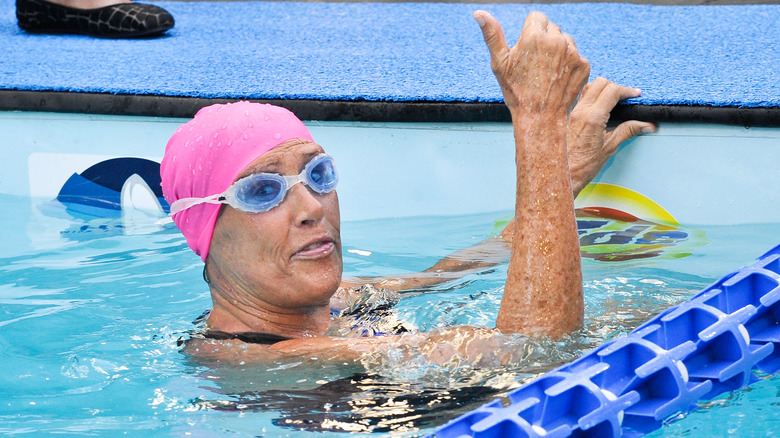The Controversy Surrounding Diana Nyad And Her Famous Swim Explained
It's pretty rare for people in their 60s to set sporting records, but that's exactly what the celebrated swimmer Diana Nyad did back in 2013 with a feat that made headlines around the world. Nyad, who specializes in long-distance swimming, accomplished a feat that no other swimmer of any age had done before, crossing from Havana, Cuba, to Florida through the shark and jellyfish-infested waters of the Florida Strait. She was 64 at the time.
A test of both mettle and endurance, the swim took a total of 53 hours, with Nyad departing Havana on the morning of August 31 and arriving at her destination of Key West, Florida, more than two days later, at around 2 p.m. on September 2.
But while few would argue that the swim was in any way an easy feat, Nyad's achievement has remained controversial in the field of long-distance swimming, with a bevy of objections meaning that the crossing is still to be ratified, nor can it be found in the record books.
Objections from skeptics
Diana Nyad's inspirational feat came after many decades of perseverance and failure. Per Biography, Nyad first attempted to swim from Cuba to Florida way back in 1978 but had to abandon the attempt due to dangerous weather conditions and countless painful jellyfish stings. She underwent three more failed attempts before her successful 2013 crossing made her a legend in the world of swimming. However, her achievement is not without controversy. Some have questioned to what degree Nyad was helped in her feat by her team, with some suggesting she may have even been helped onto one of the boats for a time to help drag her to her destination.
Much of the controversy came about due to a 5.5-hour stretch of the swim in which it appeared that Nyad was swimming at twice her usual speed — a freakish occurrence for any swimmer, let alone one that was plugging away in difficult waters for more than two days at a time.
However, naysayers concerning Nyad's incredible speed were soon silenced when oceanography professor Tamay Ozgokmen of the University of Miami publicly confirmed that the swimmer had benefitted from the prevailing current of the Gulf Stream, which allowed for incredibly high swimming speeds, according to The Guardian.
The question marks that remain
Despite facing up to the concerns of the long-distance swimming community, Diana Nyad's superhuman swim from Cuba to Florida has remained controversial in the sport. One aspect of the swim that critics continue to question was her use of a specially designed wetsuit and mask, which Nyad wore to prevent jellyfish stings. Per Biography, challenges such as Nyad's are typically conducted to abide by "English Channel rules," which only allow for a cap and goggles. Similarly, swimmers are not typically allowed to be touched by members of their support team, but in this case, it has been confirmed that Nyad was helped into and out of the suit by those who accompanied her on her journey. Per The Guardian, Nyad has argued that her use of the suit was an important safety measure. But not everything about Nyad's feat can be described as giving her an unfair advantage. For example, Slate reports that the swimming legend completed the attempt without a traditional shark cage, instead having opted for a team of experts deploying shark-repellent technology.
In the name of maintaining a level playing field in sports, in 2022 The World Open Water Swimming Association published a detailed report regarding Nyad's 2013 crossing from Cuba to Florida, which found no direct evidence of cheating. To this day, Nyad is still fighting to get her historic crossing of the Florida Straight ratified.


